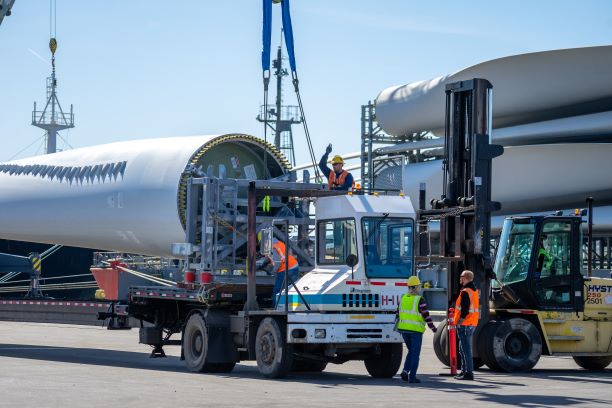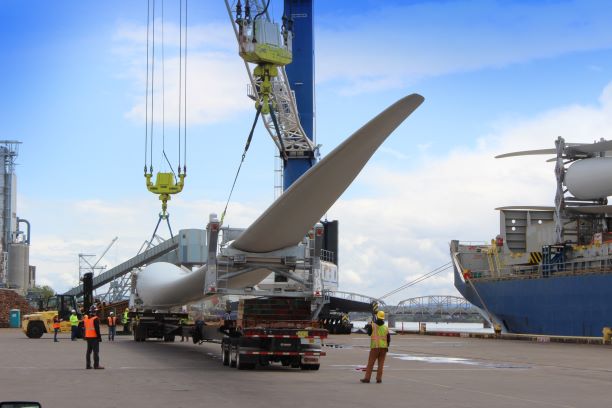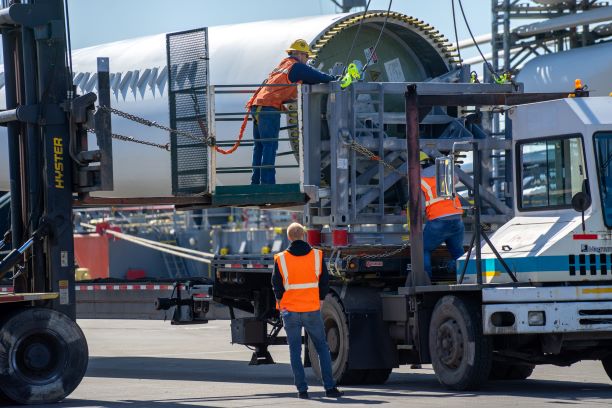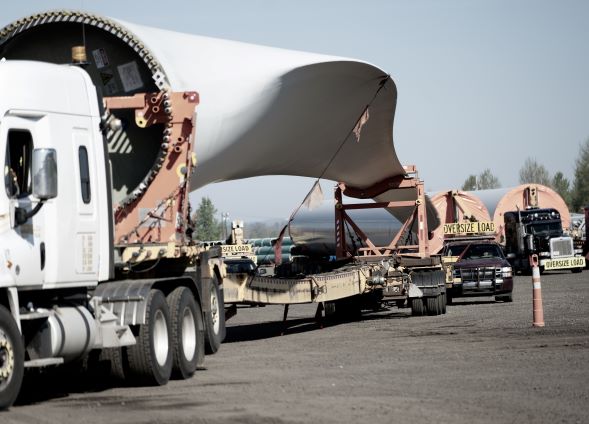Archives
Freight News, Sea
WHITE PAPER: Shipments of Enormous Wind Turbines Demonstrate Port of Vancouver USA’s Breakbulk Capabilities
[ October 26, 2020 // Gary G Burrows ]The safe and efficient movement of exceptionally big and bulky freight not only takes expertise, but extraordinary infrastructure. A seaport with ample laydown space, infrastructure, exceptional equipment, experienced labor force and transport connections to accommodate the job is an essential requirement
Enter the Port of Vancouver USA, which was tasked in July to handle a major delivery of wind turbines — a joint effort between turbine manufacturer Goldwind Americas and wind project owner Potentia Renewables.
The job involved four complete, 76-meter-long wind turbine blades — the longest ever imported into North America, and four additional turbines of the same model with blades arriving as a part of later shipments. The GW155/4.2 MW turbines measure almost 250 ft. in length. The blades are nearly as tall as the Statue of Liberty. Their final destination is Assiniboia, Saskatchewan, Canada to the Potentia Renewable’s Golden South Wind Energy Project located on 34,000 acres of leased-agricultural land. The project broke ground in 2019 and is expected to open in 2021.
Delivering turbines of this size presents many new challenges that must be met with great planning and expertise. “Given the sheer size of these wind blades and the fact that no other port on the West Coast had handled this size of blades before, there was a significant amount of advance planning that went into making this project a success,” says Alex Strogen, CCO, Port of Vancouver USA.
Port customers know the Port of Vancouver USA can handle these oversize cargo types given its 18-plus years’ experience, two heavy lift cranes, acres of laydown space and dedication to renewable energy – that’s why they continue to call on and direct cargo through this port given its ability to quickly and efficiently move cargo of all types. Its labor teams have in-depth knowledge of handling procedures, fixture types and other manufacturer-specific requirements that allows the port to accommodate the full array of component types, sizes and designs rapidly, efficiently and safely. The operators of the port’s two heavy-lift Liebherr cranes are experts in engineered and tandem lifts. Plus, representatives from heavy-haul trucking companies are on-site to manage cargo movement.
“The port worked with our stakeholders to determine the best route for the blades to follow from the vessel to the laydown yard,” Strogen explains. “After determining that route, the port undertook modifications of our existing infrastructure to ensure that the blades moved safely without any obstacles that might risk damage. Our labor partners were engaged to ensure they were satisfied with both the equipment that would be used to transport the components as well as the route that would be followed. A number of tests were executed with mock-ups of the blades to ensure that all of our calculations were correct before the actual blades arrived at the port.”
In this case, once the wind turbine blades and other major components are unloaded from the ship, they are moved to laydown space at the port’s Terminal 2 and Terminal 5.
The Terminal 5 facility features more than 80 acres of laydown space immediately adjacent to the deep-draft shipping channel.
From there, the blades are transported by Totran Transportation Services over the span of several months to Saskatchewan.
Geography also plays a major factor given that the port is just over 100 miles up the Columbia River from the Pacific Ocean. This enables shippers to bypass the congestion of other coastal ports. In addition, the Port of Vancouver USA lies at the nexus of two interstate highways and a continent-spanning rail network, providing direct access from Asia to the US Midwest and Central Canada. In contrast to most other West Coast ports, the port also has vast amounts of acreage available for marshaling and short-term storage of large wind components.
The port will eventually handle a total of 50 full turbines, a combination of the GW 136/4.2 and GW 155/4.2 MW models, for the Golden South Wind Project. In total, Goldwind will import more than 750 large-scale components through the Port of Vancouver USA.




Tags: Port of Vancouver USA









